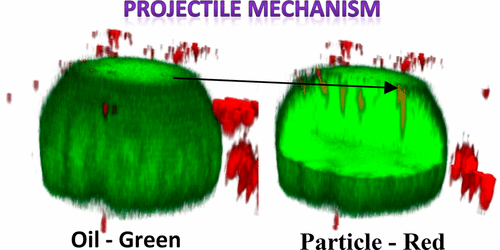当前位置:
X-MOL 学术
›
Environ. Sci. Technol.
›
论文详情
Our official English website, www.x-mol.net, welcomes your feedback! (Note: you will need to create a separate account there.)
A New Mechanism of Sediment Attachment to Oil in Turbulent Flows: Projectile Particles
Environmental Science & Technology ( IF 11.4 ) Pub Date : 2017-09-20 00:00:00 , DOI: 10.1021/acs.est.7b02032 Lin Zhao 1 , Michel C. Boufadel 1 , Joseph Katz 2 , Gal Haspel 3 , Kenneth Lee 4 , Thomas King 4 , Brian Robinson 4
Environmental Science & Technology ( IF 11.4 ) Pub Date : 2017-09-20 00:00:00 , DOI: 10.1021/acs.est.7b02032 Lin Zhao 1 , Michel C. Boufadel 1 , Joseph Katz 2 , Gal Haspel 3 , Kenneth Lee 4 , Thomas King 4 , Brian Robinson 4
Affiliation

|
The interaction of oil and sediment in the environment determines, to a large extent, the trajectory and fate of oil. Using confocal microscope imaging techniques to obtain detailed 3D structures of oil–particle aggregates (OPAs) formed in turbulent flows, we elucidated a new mechanism of particle attachment, whereby the particles behave as projectiles penetrating the oil droplets to depths varying from ∼2 to 10 μm due to the hydrodynamic forces in the water. This mechanism results in a higher attachment of particles on oil in comparison with adsorption, as commonly assumed. The projectile hypothesis also explains the fragmentation of oil droplets with time, which occurred after long hours of mixing, leading to the formation of massive OPA clusters. Various lines of inquiry strongly suggested that protruding particles get torn from oil droplets and carry oil with them, causing the torn particles to be amphiphillic so that they contribute to the formation of massive OPAs of smaller oil droplets (<∼5–10 μm). Low particle concentration resulted in large, irregularly shaped oil blobs over time, the deformation of which without fragmentation could be due to partial coverage of the oil droplet surface by particles. The findings herein revealed a new pathway for the fate of oil in environments containing non-negligible sediment concentrations.
中文翻译:

泥沙在湍流中附着于油的新机理:射弹颗粒
油和沉积物在环境中的相互作用在很大程度上决定了油的轨迹和命运。使用共聚焦显微镜成像技术获得湍流中形成的油-颗粒聚集体(OPA)的详细3D结构,我们阐明了一种新的颗粒附着机制,其中颗粒表现为穿透油滴的弹丸,其穿透深度从约2到10不等由于水中的水动力,μm。通常认为,与吸附相比,该机理导致颗粒在油上的附着更高。弹丸假设还解释了油滴随时间的分裂,这种情况是长时间混合后发生的,导致形成大量的OPA团簇。各种各样的研究强烈建议,突出的颗粒会从油滴中撕裂并带走油,导致被撕裂的颗粒是两亲性的,因此它们有助于形成较小的油滴(<〜5-10μm)的大块OPA。低的颗粒浓度会导致较大的不规则形状的油团随时间流逝,其变形而不会碎裂可能是由于颗粒部分覆盖了油滴表面。本文的发现揭示了在含不可忽略的沉积物浓度的环境中石油命运的新途径。其变形而没有碎裂可能是由于颗粒部分覆盖了油滴表面。本文的发现揭示了在含不可忽略的沉积物浓度的环境中石油命运的新途径。其变形而没有碎裂可能是由于颗粒部分覆盖了油滴表面。本文的发现揭示了在含不可忽略的沉积物浓度的环境中石油命运的新途径。
更新日期:2017-09-20
中文翻译:

泥沙在湍流中附着于油的新机理:射弹颗粒
油和沉积物在环境中的相互作用在很大程度上决定了油的轨迹和命运。使用共聚焦显微镜成像技术获得湍流中形成的油-颗粒聚集体(OPA)的详细3D结构,我们阐明了一种新的颗粒附着机制,其中颗粒表现为穿透油滴的弹丸,其穿透深度从约2到10不等由于水中的水动力,μm。通常认为,与吸附相比,该机理导致颗粒在油上的附着更高。弹丸假设还解释了油滴随时间的分裂,这种情况是长时间混合后发生的,导致形成大量的OPA团簇。各种各样的研究强烈建议,突出的颗粒会从油滴中撕裂并带走油,导致被撕裂的颗粒是两亲性的,因此它们有助于形成较小的油滴(<〜5-10μm)的大块OPA。低的颗粒浓度会导致较大的不规则形状的油团随时间流逝,其变形而不会碎裂可能是由于颗粒部分覆盖了油滴表面。本文的发现揭示了在含不可忽略的沉积物浓度的环境中石油命运的新途径。其变形而没有碎裂可能是由于颗粒部分覆盖了油滴表面。本文的发现揭示了在含不可忽略的沉积物浓度的环境中石油命运的新途径。其变形而没有碎裂可能是由于颗粒部分覆盖了油滴表面。本文的发现揭示了在含不可忽略的沉积物浓度的环境中石油命运的新途径。



























 京公网安备 11010802027423号
京公网安备 11010802027423号